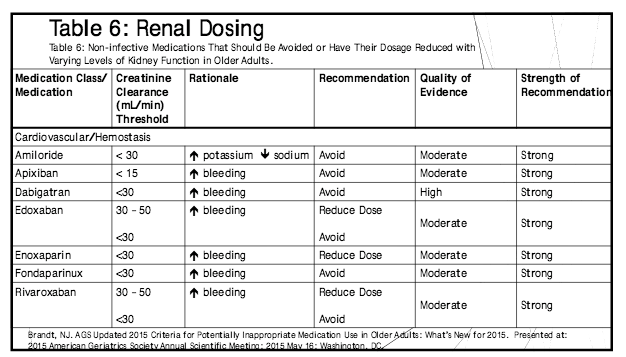Article
4 Factors Contributing to Inappropriate Renal Dosing
Author(s):
One major addition to the 2015 American Geriatrics Society Beers Criteria is a renal dosing table.
One major addition to the 2015 American Geriatrics Society Beers Criteria is a renal dosing table.
This table describes non-infective medications that should be avoided or have their dosage reduced with varying levels of kidney function in older adults. According to the 2015 Beers Criteria, the drugs and drug-drug interactions that pose the most risk without a dose adjustment include amiloride, edoxaban, and proton pump inhibitors.

Although the introduction of this table is a concerted step towards improving outcomes for some older patients, panelists at the 2015 American Society of Consultant Pharmacists (ASCP) Annual Meeting and Exhibition in Las Vegas, Nevada, explained that several human errors and misconceptions held by health care providers also need to be addressed in order to reduce renal dosing errors.
Here are 4 factors contributing to inappropriate renal dosing:
1. Renal Dosing Is Highly Individualized
Demetra Antimisiaris, PharmD, CGP, FASCP, explained to Pharmacy Times that renal dosing adjustments are not a one-size-fits-all strategy.
A young person with 1 chronic disease taking just a few medications has a lot of physiological reserve and can sustain extremes in drug dosing, she explained.
Meanwhile, an older person with many chronic diseases on several different medication regimens may already have impaired kidney function and low physiological reserve, making them more predisposed to injuries due to inappropriate renal dosing.
“So, for that older person, renal dosing has to be much more aggressive,” Dr. Antimisiaris said.
2. Renal Dosing Isn’t Usually Considered Until It’s a Problem
According to Dr. Antimisiaris, renal dosing is usually addressed only after a patient has gone into acute renal failure or exhibited some other obvious sign of toxicity.
This can be more clearly seen when evaluating an elderly patient’s transition from a long-term care facility to a geriatric emergency department (ED). Critical patient information is not always properly communicated between the 2 settings, and communication barriers could ultimately lead to delays in care or inappropriate care.
“Sometimes, [elderly patients] are more sick than they’re able to communicate…and in the ED, we don’t know what their baseline is,” Stephanie Callinan, PharmD, CGP, of the US Department of Veterans Affairs, told session attendees during a separate panel discussion at ASCP.
3. Many Medications Have Renal Adjustments That Providers Don’t Screen For
Many medications have pretty significant renal adjustment guidelines that are not properly evaluated, including some statins, the diabetes medication canagliflozin (Invokana), the community-acquired pneumonia treatment ceftaroline (Teflaro), and the antidepressant duloxetine (Cymbalta).
This creates an opportunity for pharmacists who are well trained in renal adjustments as medication experts. Pharmacists can provide education and safety information to other health care providers.
In addition, Dr. Animisiaris said pharmacists have “extraordinary access” to patients because they are “disseminated throughout the community in many different health settings,” and therefore have ample opportunity to check in with them to monitor their renal health.
“I always tell my [pharmacy] students you can see kidney impairment walking down the street,” she quipped.
4. Our Health System Has an Unclear Division of Labor for Renal Dosing
In our complex health system, there “doesn’t seem to be any one person or profession’s obligation to make sure that [renal dosing] happens correctly,” Dr. Antimisiaris told Pharmacy Times.
This unclear division of labor creates room for renal dose adjustment errors, so health care providers will need to take a “systemic approach” to ensure that every medication prescribed “gets screened for necessary dosing adjustments as applied to every individual patient,” she explained.
Newsletter
Stay informed on drug updates, treatment guidelines, and pharmacy practice trends—subscribe to Pharmacy Times for weekly clinical insights.





